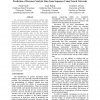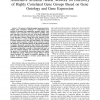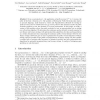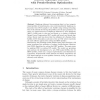123
click to vote
CIBCB
2007
IEEE
15 years 4 months ago
2007
IEEE
The accurate prediction of enzyme catalytic sites remains an open problem in bioinformatics. Recently, several structure-based methods have become popular; however, few robust seq...
107
click to vote
CIBCB
2007
IEEE
15 years 4 months ago
2007
IEEE
Gene regulatory network model is the most widely used mechanism to model and predict the behavior of living organisms. Network Component Analysis (NCA) as an emerging issue for unc...
144
click to vote
CIBCB
2007
IEEE
15 years 4 months ago
2007
IEEE
Abstract-- The advance of high-throughput experimental technologies poses continuous challenges to computational data analysis in functional and comparative genomics studies. Gene ...
105
click to vote
BICOB
2009
Springer
15 years 4 months ago
2009
Springer
Protein-protein interaction plays critical roles in cellular functions. In this work, we propose a computational method to predict protein-protein interaction by using support vec...
89
Voted
AB
2007
Springer
15 years 4 months ago
2007
Springer
Lie group theory states that knowledge of a m-parameters solvable group of symmetries of a system of ordinary differential equations allows to reduce by m the number of equations. ...
105
Voted
AB
2007
Springer
15 years 4 months ago
2007
Springer
Given a permutation , the application of prefix reversal f(i) to reverses the order of the first i elements of . The problem of Sorting By Prefix Reversals (also known as pancake ...
103
click to vote
AB
2007
Springer
15 years 4 months ago
2007
Springer
Abstract. Haplotype inference from genotype data is a key computational problem in bioinformatics, since retrieving directly haplotype information from DNA samples is not feasible ...
132
click to vote
EBERNBURG
1990
15 years 4 months ago
1990
In the theory of living systems any description of self-organizing processes is confronted by a very central problem concerning the role of the system's boundary, i.e., there...
104
click to vote
RECOMB
1997
Springer
15 years 5 months ago
1997
Springer
We present a new polynomial time approximation scheme (PTAS) for tree alignment, which is an important variant of multiple sequence alignment. As in the existing PTASs in the liter...
76
Voted
RECOMB
1997
Springer
15 years 5 months ago
1997
Springer




